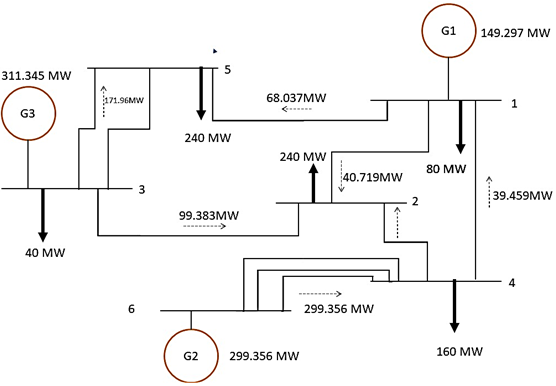Transmission line planning using global best artificial bee colony method
DOI:
https://doi.org/10.20998/2074-272X.2023.5.12Keywords:
artificial intelligence, artificial bee colony, transmission line network planning, load flow analysisAbstract
Introduction. Network expansion, substation planning, generating expansion planning, and load forecasting are all aspects of modern power system planning. The aim of this work is to solve network planning considering both future demand and all equality and inequality constraints. The transmission network design problem for the 6-bus system is considered and addressed using the Global Best Artificial Bee Colony (GABC) method in this research. The program is written in the Matrix Laboratory in MATLAB environment using the proposed methodology. Novelty of the work consist in considering the behavior of bees to find food source in most optimized way in nature with feature of user based accuracy selection and speed of execution selection on any scale of the system to solve Transmission Lines Expansion Problem (TLEP). The proposed method is implemented on nonlinear mathematical function and TLEP function. When demand grows, the program output optimally distributes new links between new generation buses and old buses, determines the overall minimum cost of those links, and determines if those linkages should meet power system limits. Originality of the proposed method is that it eliminated the need of load shedding while planning the future demand with GABC method. Results are validated using load flow analysis in electrical transient analyzer program, demonstrating that artificial intelligence approaches are accurate and particularly effective in non-linear transmission network planning challenges. Practical value of the program is that it can use to execute cost oriented complex transmission planning decision.
References
Desai J.P. Analysis of Power Swings and Blackouts. 2021 IEEE Congreso Estudiantil de Electrónica y Electricidad (INGELECTRA), 2021, pp. 1-6. doi: https://doi.org/10.1109/INGELECTRA54297.2021.9748070.
Seifi H., Sepasian M.S. Electric Power System Planning: Issues, Algorithms and Solutions. Springer Science & Business Media, 2011.
Rathore C., Roy R. Load uncertainty based transmission network expansion planning. 2013 3rd International Conference on Electric Power and Energy Conversion Systems, 2013, pp. 1-6. doi: https://doi.org/10.1109/EPECS.2013.6713034.
Mahdad B., Srairi K. Interactive artificial ecosystem algorithm for solving power management optimizations. Electrical Engineering & Electromechanics, 2022, no. 6, pp. 53-66. doi: https://doi.org/10.20998/2074-272X.2022.6.09.
Mehdi M.F., Ahmad A., Ul Haq S.S., Saqib M., Ullah M.F. Dynamic economic emission dispatch using whale optimization algorithm for multi-objective function. Electrical Engineering & Electromechanics, 2021, no. 2, pp. 64-69. doi: https://doi.org/10.20998/2074-272X.2021.2.09.
Desai J.P. Three-Terminal Transmission Line Protection By Considering Effect of Infeed Current. Journal of The Institution of Engineers (India): Series B, 2022, vol. 103, no. 6, pp. 2165-2175. doi: https://doi.org/10.1007/s40031-022-00795-7.
Razavi S.E., Arefi A., Ledwich G., Nourbakhsh G., Smith D.B., Minakshi M. From Load to Net Energy Forecasting: Short-Term Residential Forecasting for the Blend of Load and PV Behind the Meter. IEEE Access, 2020, vol. 8, pp. 224343-224353. doi: https://doi.org/10.1109/ACCESS.2020.3044307.
Garver L. Transmission Network Estimation Using Linear Programming. IEEE Transactions on Power Apparatus and Systems, 1970, vol. PAS-89, no. 7, pp. 1688-1697. doi: https://doi.org/10.1109/TPAS.1970.292825.
Gao W., Liu S., Huang L. A global best artificial bee colony algorithm for global optimization. Journal of Computational and Applied Mathematics, 2012, vol. 236, no. 11, pp. 2741-2753. doi: https://doi.org/10.1016/j.cam.2012.01.013.
Saif U., Guan Z., Zhang L., Mirza J., Lei Y. Hybrid Pareto artificial bee colony algorithm for assembly line balancing with task time variations. International Journal of Computer Integrated Manufacturing, 2017, vol. 30, no. 2-3, pp. 255-270. doi: https://doi.org/10.1080/0951192X.2016.1145802.
Desai J., Makwana V. Power Swing Blocking Algorithm based on Real and Reactive Power Transient Stability. Electric Power Components and Systems, 2020, vol. 48, no. 16-17, pp. 1673-1683. doi: https://doi.org/10.1080/15325008.2021.1906794.
Desai J.P., Makwana V.H. A novel out of step relaying algorithm based on wavelet transform and a deep learning machine model. Protection and Control of Modern Power Systems, 2021, vol. 6, no. 1, art. no. 40. doi: https://doi.org/10.1186/s41601-021-00221-y.
Aoyang H., Shengqi Z., Xuehui J., Zhisheng Z. Short-term Load Forecasting Model Based on RBF Neural Network Optimized by Artificial Bee Colony Algorithm. 2021 IEEE 2nd International Conference on Big Data, Artificial Intelligence and Internet of Things Engineering (ICBAIE), 2021, pp. 486-489. doi: https://doi.org/10.1109/ICBAIE52039.2021.9390043.
Bozogullarindan E., Bozogullarindan C., Ozturk C. Transfer Learning in Artificial Bee Colony Programming. 2020 Innovations in Intelligent Systems and Applications Conference (ASYU), 2020, pp. 1-7. doi: https://doi.org/10.1109/ASYU50717.2020.9259801.
Mínguez R., García-Bertrand R., Arroyo J.M. Adaptive Robust Transmission Network Expansion Planning using Structural Reliability and Decomposition Techniques. Computational Engineering, Finance, and Science, 2015, 12 p. doi: https://doi.org/10.48550/arXiv.1501.06613.

Downloads
Published
How to Cite
Issue
Section
License
Copyright (c) 2023 J. P. Desai

This work is licensed under a Creative Commons Attribution-NonCommercial 4.0 International License.
Authors who publish with this journal agree to the following terms:
1. Authors retain copyright and grant the journal right of first publication with the work simultaneously licensed under a Creative Commons Attribution License that allows others to share the work with an acknowledgement of the work's authorship and initial publication in this journal.
2. Authors are able to enter into separate, additional contractual arrangements for the non-exclusive distribution of the journal's published version of the work (e.g., post it to an institutional repository or publish it in a book), with an acknowledgement of its initial publication in this journal.
3. Authors are permitted and encouraged to post their work online (e.g., in institutional repositories or on their website) prior to and during the submission process, as it can lead to productive exchanges, as well as earlier and greater citation of published work.




